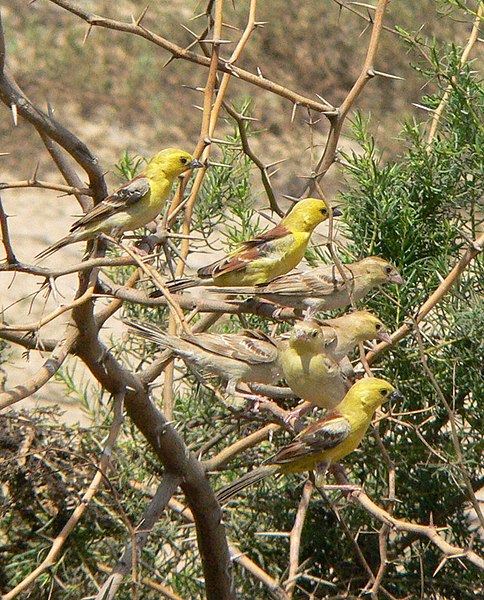 One glance at a male Golden Sparrow (Passer/Auripasser luteus) will quickly dispel the common notion that all sparrows are drab, uninteresting creatures. Also known as the Yellow Sparrow, Sudan Golden Sparrow and Golden Song Sparrow, the bright yellow-gold plumage of some males, offset by chestnut-colored wings, outshines that of the better-known Canary.
One glance at a male Golden Sparrow (Passer/Auripasser luteus) will quickly dispel the common notion that all sparrows are drab, uninteresting creatures. Also known as the Yellow Sparrow, Sudan Golden Sparrow and Golden Song Sparrow, the bright yellow-gold plumage of some males, offset by chestnut-colored wings, outshines that of the better-known Canary.
Natural History
Hailing from Northern and Eastern Africa, Golden Sparrows are closely related to the ubiquitous House Sparrow (Passer domesticus), and indeed have hybridized with this species in captivity. Female Golden Sparrows resemble their common, somberly-clad relatives somewhat in color.
They are native to hot, arid habitats and favor thorn scrub, desert fringes and wooded grasslands. Golden Sparrows are, however, quite adaptable, and are sometimes common on farms, ranches and in even in large cities. They usually forage in large flocks, sometimes in the company of similarly-sized seed-eaters of other species.
Enclosure
Golden Sparrows are always on the move, investigating their environment, foraging for food and making nest repairs. Consequently, despite being a mere 5.5 inches in length, they are best suited to life in outdoor aviaries or indoor bird rooms. Little if any success has been had in keeping and breeding these energetic little songsters in cages.
Breeding
Golden Sparrows are more commonly bred in Europe than the USA, but are gaining in popularity each year. In addition to brilliant coloration, the pleasant song of the male also serves to endear them to aviculturists.
In the wild, Golden Sparrows breed in loose colonies, with 50 or more pairs often nesting in close proximity to one another. Captives, however, vary in this regard – some are quite willing to accept company, while other pairs become extremely aggressive towards others of their kind when rearing young.
Outside of the breeding season, Golden Sparrows will usually co-exist well with Java Rice Birds and similarly-sized species, but often harass or even kill small finches. I’ve kept them in large zoo exhibits with Golden Weavers, Pin-tailed Whydahs and Red Bishops.
 Pairs will utilize wicker baskets in which to construct their dome-shaped grass nests, but prefer thick bushes. The greenish-white eggs, marked with gray and brown, are quite beautiful. You should, however, resist the urge to examine them, as Golden Sparrow parents are invariably high strung and quickly abandon their nest if disturbed.
Pairs will utilize wicker baskets in which to construct their dome-shaped grass nests, but prefer thick bushes. The greenish-white eggs, marked with gray and brown, are quite beautiful. You should, however, resist the urge to examine them, as Golden Sparrow parents are invariably high strung and quickly abandon their nest if disturbed.
An average clutch consists of 3-4 eggs, which hatch in 10-13 days. Two or three clutches may be produced each year. The young fledge within 2 weeks and reach sexual maturity when approximately 1 year old. Captives have lived in excess of 10 years.
Diet
Parents rearing young should be provided with ample amounts of small live crickets, mealworms and other insects, egg food, sprouts and a quality seed-based finch food. Millet Sprays and small bits of apple, peaches, pears and other fruits are appreciated year-round.
Grit and cuttlebone should always be available.
Further Reading
Fact Sheets on this and other birds in the National Aviary’s extensive collection.
Golden Sparrow images referenced from wikipedia and originally posted by ChriKo
 That Bird Blog – Bird Care and History for Pet Birds
That Bird Blog – Bird Care and History for Pet Birds




I had a pair of golden song sparrows given to not realising they were aviary birds had them in a double breeder ,put a nest box up ever hopeful with coconut fibre ,and other fibres to find 3 eggs thinking little about it .when I checked again had 3 chicks which are now out full feathered and independant
Nice to hear..thank you! Please post updates when possible, enjoy, Frank